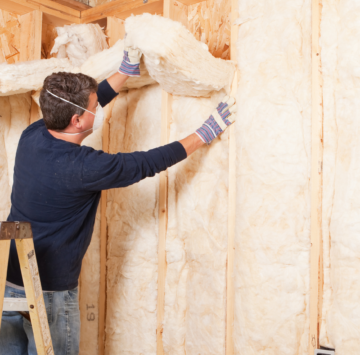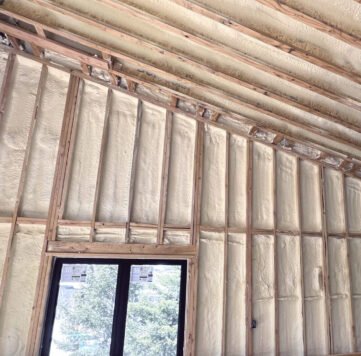Retrofit
Insulation
Retrofit insulation is often also referred to as re-insulation. It means adding insulation or installing new insulation into your existing home.
This method is popular for older homes with outdated or degraded insulation, remodels, or even unfinished basements, but really, any building can benefit from a good old retrofit!
So, how does retrofit insulation work? It’s pretty similar to new construction insulation installation. The standard re-insulation process looks like this:
Inspection: The first step in the retrofit process is a thorough inspection of your existing insulation or lack of insulation. Insulation professionals assess the condition and performance of your current insulation to determine what needs to be done.
Removal (if necessary): If the existing insulation is wet, damaged, or infested with pests, it will need to be removed before new insulation can be added.
Adding new insulation: Once the old insulation has been dealt with (either removed or deemed fit to stay), new insulation can be added. The insulation material is chosen based on a variety of factors, including your home’s specific needs, the local climate, and your budget.
Post-installation check: After the new insulation is in place, a final check is conducted to ensure everything is properly installed and performing as it should.
Follow-up: Professionals will provide guidance on any necessary maintenance or follow-up measures to keep your insulation performing optimally.
When retrofitting your home, certain areas are high-priority insulation zones.
These include:
Attic: The attic is a major culprit for heat loss in your home. In winter, warm air rises and can escape through your attic, while in summer, heat from the sun can turn your attic into an oven, radiating heat into your living space. Insulating your attic is a key step toward maintaining a comfortable home temperature year-round.
Walls: Did you know that up to 35% of heat loss in your home occurs through the walls? Insulating your walls effectively traps heat inside in the winter and repels heat in the summer, making your home more energy-efficient and comfortable.
Floors: Ever walked across a cold floor in the middle of winter? Not fun. While they’re not as crucial as attics or walls, insulating floors, especially those above unheated spaces like garages or basements, can help enhance your home’s overall comfort. Spraying your floor joists with closed-cell foam can also improve those pesky squeaks as you walk across your floor.
Basement or crawl space: These areas are often neglected, but insulating them comes with many benefits. Depending on your area, different codes may apply to the basement walls and crawl spaces. Insulating your basement or crawl space walls will reduce drafts and help maintain consistent temperature in your home. Adding a vapor barrier in your crawl space will also help prevent moisture buildup.

Batt / Basic
Annual Savings from Proper Insulation: $0 (based on 1500 ft² rambler with $250/mo utilities)
Batting is a fiberglass blanket that comes in various densities, widths, and lengths and is cut to fit the space in the framing of walls and ceilings. It is typically used in entry-level homes and at less-than-optimal levels.
- Most common
- Lowest cost
- Easy to install
- R-Values from 8-38
- Noise control for walls, ceilings, and floors
- Fire resistant

Blown Fiberglass / Better
Annual Savings from Proper Insulation: $600 (20% savings) (based on 1500 ft² rambler with $250/mo utilities)
Blown-in insulation, using either cellulose or fiberglass, is applied to frame cavities using compressed air. This application allows the insulation to completely fill in all nooks and crannies whereas batt insulation may allow energy loss.
- Quick and easy installation.
- Fills the entire cavity.
- More efficient – higher r-value per inch.
- Fire retardant & fire resistant.
- Excellent sound barrier.

Closed-Cell Spray Foam / Best
Annual Savings from Proper Insulation: $1,200 (40% savings) (based on 1500 ft² rambler with $250/mo utilities)
SPF, Closed-Cell Foam is the most advanced insulation material. The high-density foam is sprayed onto surfaces and hardens immediately to form a seamless bond with building components and completely seals the building envelope to create a structurally sound, uniform, air-infiltration barrier that also blocks moisture (no mold or rot), bugs, rodents, dirt, allergens, and noise. Foam is most commonly used in conjunction with batt and/or blown-in insulation to provide an optimal solution that can save homeowners up to 40% on their energy bills, ensuring a quick return on the investment and $1,000s in savings.
- Most efficient with r-value of 6.0 per inch
- Completely seals building envelope from air, moisture, sound, and pests
- Increased structural strength
- Better indoor air quality
- Eco-friendly (VOC-free and zero ozone depletion)
- Applied to all construction materials
Benefits of proper insulation:
- Reduce your heating and cooling bills.
- Leave the noise outside and keep it quiet inside.
- Extend the life of your heating/cooling equipment.
- Reduce the likelihood of water and mold issues.
- Take advantage of tax credits & rebates.
- Protects your home against Mother Nature.
Certified Professionals
We pre-screen and regularly review our contractors so you can confidently hire the right pro.
